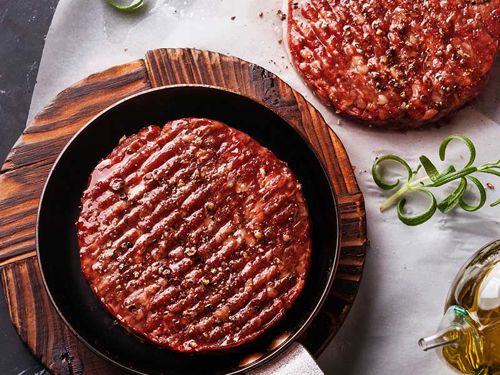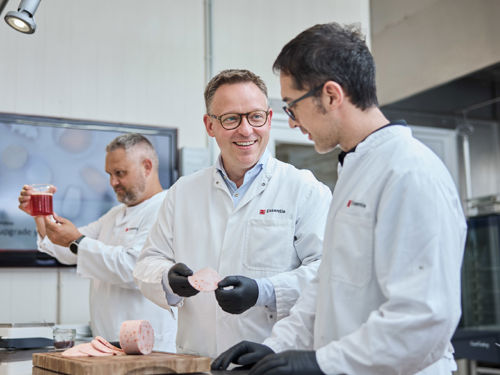With the rise in global meat prices, it has become even more important to explore ways of optimizing the production process and keeping costs down while not compromising on quality. This can be done by replacing part of the meat content with other ingredients.
Watch the video below for better insights into the challenge.
Transcription of the video
"With global meat prices increasing, it has become even more important to look at how you can optimize your products and keep the cost for meat applications down.
A way to do this is to replace a part of the meat with other ingredients.
We have invited meat application specialist, Carsten Doktor, for deeper insights into the options and challenges evolving around meat replacement.
Welcome, Carsten. Thank you, Maya.
Before we go into details, I'd like to know where meat replacement is typically used?
Meat replacement is typically used in products where you would like to lower the cost for your production.
You can use, and this is the main reason for doing it, with the use of functional ingredients, you can then obtain some different benefits, which could be improved sliceability, it could be a better modification, and for sure, also a better purge control.
Some of the applications where you can replace meat could be emulsified products, like cold cuts.
It could be for meat balls, hot dog, frankfurters, and that kind of products.
You can also replace, I would say, extend meat for reformed and for injected products, as well.
Of course, when we are talking about meat extension, you can say, is this the same as meat replacement?
Somehow it is, because we are adding more water into the meat and that is also meat replacement, actually.
As a guideline, how much meat can you replace?
Well, that depends on what type of products we're talking about.
In the case here, where we have some meat balls, we have replaced 5 % of the meat.
Here, we have two different types of frankfurters, one with cheese and one without. And, in both cases, we have replaced 10 % of the meat.
Then in a fermented product like this, it is also possible to replace a lot of meat. In this case, it is a 15 % that is replaced.
And for the cold cut, we have replaced 30 %.
And then, for our injected ham, a whole muscle injected ham, we can, as we spoke about earlier, extended it and this is between 40 and 100 % extension.
And for restructured products, we can I would say we can go up … yeah... where's the limit? We have already made trials with the 250 % extension and that is meat plus 250 % extension which is, I would say, quite a lot.
How do you estimate the dosage you want to use?
Well, this is where we are using our application centers a lot. We have two application centers where we are making a lot of trials when we are working with. It can be ideas created by ourselves or it can be a request from a customer.
So in the case where it's a request from a customer, we can work with their formulations and then we can see what it's possible to do. We know which proteins to work with, which one would fit best into a meat ball, into a frankfurter, or into an injected piece of meat. And then we'll play with the dosages depending on what the customers want.
We know that in many parts of the world, soy protein is also used as a meat replacer. How would functional meat proteins compete with that?
Well, looking down the price, we cannot compete one to one. Soy is cheaper per kilo compared to our ingredients but, when we are looking at the dosage, we need compared to the soy proteins, we need a smaller dosage and therefore we can still compete with it, cost in use.
Also, texture-wise, we can, we can have the same texture with the smaller dosage like the soy or I would say even better texture. Another thing is allergens, there are no known allergens in our proteins. We do not have any issues with GMO like soy could have, and then sustainability, well, we know that there are some issues with soy and sustainability.
Another benefit I would say with our proteins is also all of them are clean label ingredients.
So, I say in all cases, yes, we can easily compete with soy.
I'm curious to know what happens to the sensory quality of the final product when you take meat out of the formulation?
Well, in the case of this cold cut, we have replaced 30 %. I would say we have actually improved the texture.
The texture is better. And, why is that? That is because our proteins also have this benefit of giving better sliceability. So, what you will see when you try it is that the product will be more sliceable and you will have less slicing losses in your production, which is, of course, very, very important.
It's also a good way to make meat more affordable and, to ensure that the texture is the same as in the product we started with.
We will use again our texture analyzer, just like I said, with the meat balls. We will analyze it with the texture analyzer to make sure that everything remains the same.
What happens to the taste when you replace meat in your formulation?
Well, actually, nothing happens. I would say very often what could happen, if something happens, is that we improve the taste. You will see that it can be easier to taste the salt and it can also be easier to taste the spices. So, in some cases you can actually reduce the salt content and also the spice content.
Our product is very neutral in taste. There are off flavors using it. Our dosage, it's also really, really low. So there's no negative impact at all when using our proteins.
How does meat replacement change the process?
Well, simple answer. It doesn't change the process, at all. You can add the proteins just like any other ingredient, like you normally do. It can be into the bowl chopper when you are making your emulsified products. You can add them directly into the mixer. So, I would say in many cases it's not necessary to change anything.
Either, we do not recommend to make pre-gels or to make pre-hydrations, with only a few exceptions.
There could be systems where a pre-gel is a good thing to make or products where it could be a good idea to make a pre-gel.
As an example, it could be for fermented salamis. If you want to replace 10 - 15 % of the meat, it can be a good idea to make a pre-gel and then add this, instead of, because this is a raw product that is not cooked like other meat products.
Also, talking about brines, you will just add the protein as it is, into the brine and then inject with your normal procedure. So no change is needed.
From what I understand, meat-based proteins are the best option for meat replacement. Why is that?
Well, we have excellent properties when using our proteins. You can say with our proteins, we are able to bind water, we are able to bind fat as we are illustrating here in the gels we have made.
One of the gels is a water gel where we are able to bind a lot of water and the other one is a fat emulsion, actually, where we have a combined water and fat using our ingredients.
So, besides using our proteins as a meat replacer, you can also use it to replace fat. And this is without compromising the quality at all. Also, our protein is meat based. So, it's meat into meat.
How can these ingredients be declared on the back of the pack?
Well, it's hard to give a precise answer on that. First, I would say you should always check and follow local regulations. But I know in some countries, it can be declared as a part of the meat block.
But typically, I would say it will be declared as pork, beef or chicken proteins.
It is important to state that our proteins are natural origin and can be declared as clean label.
So, what we learned today is that you can replace meat in all type of meat applications.
It's a great way of achieving cost optimization for your meat products and it's making meat affordable for more people.
The meat replacement is not compromising the sensory quality and it's easy to apply and can be applied like any other ingredient.
And finally, it can even be declared as a clean label.
If you're eager to learn more about meat replacement, reach out to your local Essentia contact."



